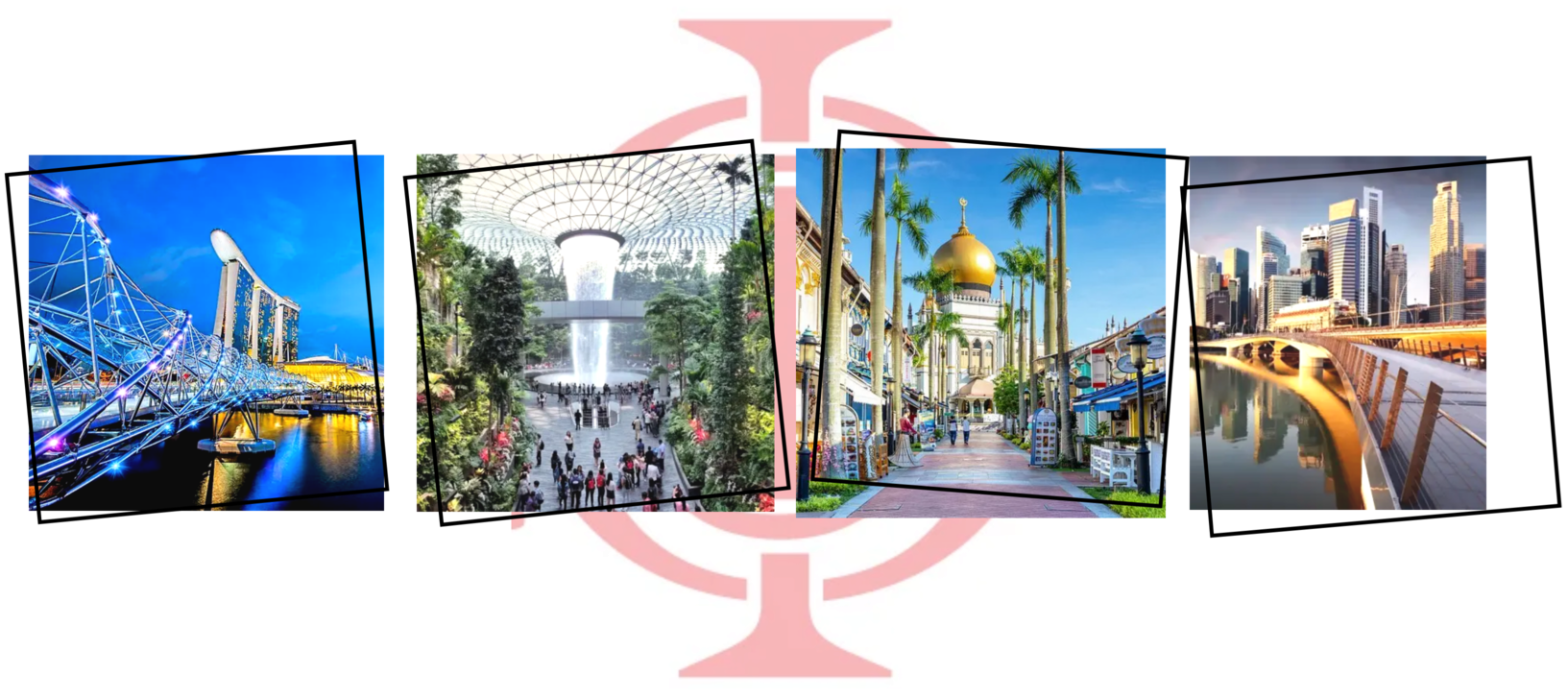About Singapore

Singapore is the largest port in Southeast Asia and one of the busiest in the world. Temperatures usually range from 23 to 32 °C (73 to 90 °F). The currency of Singapore is the Singapore dollar (SGD or S$).
Above is a daytime drone of Gardens by the Bay and Marina Bay Sands from six different angles, featuring the Singapore Flyer, the Singapore River, highrise buildings, the port, the highway, and the Esplanade in backgrounds in various scenes.
Explorers can find respite from the hustle and bustle of the city among the tropical greenery in parks and gardens, while collectors will certainly delight in innovative and uniquely Singaporean brands at world-class malls.
10 Fun Facts About Singapore
Source: www.visitingsingapore.com
|
Photo by Afur Wong |
1. It’s a city of not just one island, but 64Singapore’s land area includes as many as 64 offshore islands that surround the main island. These include Sentosa—a popular island resort with myriad attractions—and havens for nature lovers like Pulau Ubin, St John’s Island, and Sisters’ Islands. What that means for visitors: more fun in the sun! |
 |
2. It’s home to the world’s first night zooSingapore’s Night Safari provides a nocturnal experience like no other in the city; it’s also the world’s very first night zoo. Opened in 1994, the 35-hectare park features over 1,000 animals from 120 different species, living in their naturalistic nighttime environments. Hop onto the 40-minute guided tram ride for an overview of the park’s main attractions, or amble along the four interlinked walking trails within the park, for a zoo trip like no other. |
|
No trip to Singapore is complete without a visit to the world’s tallest indoor waterfall. Housed in the retail and lifestyle complex of Jewel Changi Airport, the HSBC Rain Vortex soars at 40 meters, and is surrounded by a lush indoor garden. |
3. It’s a city of (man-made) waterfallsAccording to the Mandai Wildlife Reserve, the first man-made waterfall was built at Jurong Bird Park in 1971. Dropping from a height of 30 meters, it is said to be the tallest waterfall in an aviary to date. Other man-made summits to explore include Cloud Forest and Gardens by the Bay. This huge, 35-meter waterfall is the centerpiece of the misty conservatory, designed to house plant life from the tropical highlands.
|
|
Singaporeans also tend to refer to strangers such as cab drivers and hawker center stall owners as “Aunties” and “Uncles”. This is an endearing way of addressing older gentlemen and ladies. |
4. The locals speak Singlish, not just EnglishDon’t be too surprised to hear Singaporeans adding exclamations like ‘lah’ and ‘leh’ to their sentences. Singlish— our colorful local slang— is an integral part of everyday conversation among Singaporeans. Singlish is a collection of colloquial catchphrases and lingo influenced by Singapore’s multiculturalism. Other examples include the Singlish term "chope," which means to reserve a seat. Locals often chope seats at a hawker center using packets of tissue paper! Do use these terms wisely, though, as they can connote the addressee’s age; you wouldn’t want to accidentally offend a new acquaintance! |
|
According to Formula 1, the Marina Bay Street Circuit also boasts more corners (23 in all) than any other circuit on the Formula One race calendar.
|
5. Singapore pioneered the first F1 night raceHeld annually since 2008, Grand Prix Season Singapore features a gamut of concerts, racing, and entertainment activities, for Formula One fans and visitors of all ages. The star event—the FORMULA 1 SINGAPORE GRAND PRIX—also made racing history as the world’s first-ever FORMULA 1-night race. The twisty Marina Bay street circuit has largely remained unchanged in the years since; the track’s brightly lit floodlights also add to the spectacular night views of Singapore. With the Singapore GP back on track in 2022, race fans can expect an unforgettable experience of nonstop thrills and adrenaline. |
|
Photo by Lim Wei XiangThere’s rich biodiversity in the many nature reserves that dot our City in a Garden—Singapore is home to over 2,100 native vascular plant species. |
6. It’s one of the world’s greenest citiesThis city of skyscrapers is also one that is filled with lush greenery. Nearly half of Singapore’s land area (approximately 700 square kilometers) is under green cover. Beyond numerous parks and gardens, there are pockets of undiscovered plant life housed in the most unusual of places. For example, PARKROYAL COLLECTION Pickering is known for its hotel-in-a-garden concept and its four-story cascading vertical garden. The Bukit Timah Nature Reserve, in particular, is said to contain more tree species in a single hectare than the total number of tree species found in North America. |
|
Another fun fact: Singapore’s first botanic garden opened in 1822, on the slopes of the area now known as Fort Canning Hill. Measuring just 19 hectares, the garden closed in 1829 due to rising costs. Its land was then used for various public projects, including an Armenian church, a school, and a hospital. |
7. It’s home to a UNESCO World Heritage Site and some unique ‘VIPs’ Lauded as a UNESCO World Heritage Site in 2015, the Singapore Botanic Gardens has a history of over 150 years since its founding in 1859; that’s more than a century older than modern Singapore itself! Its most popular attraction is the National Orchid Garden, which houses thousands of orchid species known as Very Important Plants (VIPs). Over 200 hybrid orchids in this garden have been affectionately named after visiting foreign dignitaries such as Nelson Mandela, the Duke and Duchess of Cambridge, as well as celebrities like actors Jackie Chan, Zhou Xun, and Bae Yong Jun.
|
|
Photo by Danny SantosMore up-and-coming neighborhoods include Everton Park, which is home to coffee joints, cafés, ice cream parlors, and other must-try foodie hotspots. |
8. There are myriad neighborhoods to explore off the beaten pathBesides the history-rich hotspots of Chinatown, Kampong Gelam , and Little India, there are many other colorful enclaves for visitors to explore in Singapore. You’ll find rows of hip eateries and stores along the Art Deco-style buildings of Tiong Bahru, as well as colorful shophouses and traditional food stalls in Joo Chiat/Katong. |
|
In July, foodies are in for a treat with the Singapore Food Festival, where they will get to savor uniquely Singaporean dishes as well as the best of Mod-Sin (Modern Singaporean) cuisine, which gives a modern twist to traditional flavors. |
9. There’s always something to celebrate in SingaporeFret not about finding fun new things to do. There are cultural festivals, and major sports, lifestyle, and arts events held all year round in the city to keep you entertained. The annual HSBC World Rugby Singapore Sevens is hosted at the S$1.3 billion Singapore Sports Hub, which also hosts a range of events, from live music concerts to mixed martial arts extravaganzas. |
|
The prince's advisors recognized the strange animal, which was moving quickly, as a lion. However, there were no records of lions native to Singapore. It might have been a tiger that he saw, for tigers used to be found in the wild in Singapore, up until the 1930s. |
10. The Lion City may have been inspired by a tigerYou may have heard about the Merlion, Singapore’s iconic emblem. The Merlion is a mythical creature with a lion’s head and a fish's tail. The city's ancient name, Singapura, which means "lion city," served as inspiration for the Merlion. The origins of this Sanskrit name are attributed to the Sumatran prince Sang Nila Utama, who ruled Temasek, a settlement on the Singapura island, during the early 14th century.
|
![]()
 Traveler Essentials
Traveler Essentials
 COVID-19 Travel Regulations Map
COVID-19 Travel Regulations Map
 18 Rules to Follow in Singapore
18 Rules to Follow in Singapore
 11 Things to Know Before Visiting Singapore
11 Things to Know Before Visiting Singapore
 Visit Singapore: Official Website
Visit Singapore: Official Website
 Overview of Singaporean Culture
Overview of Singaporean Culture
Questions? Contact info-icoms@iaoms.org.








